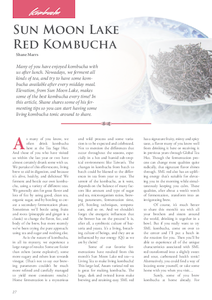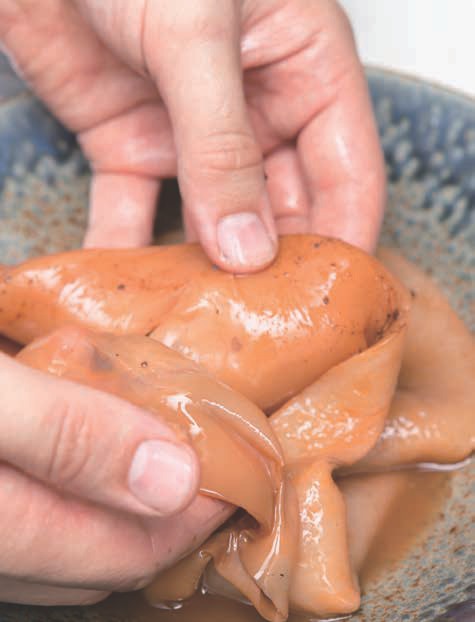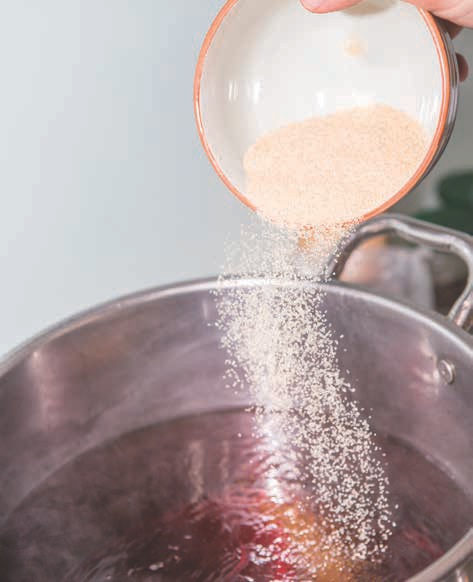
 |
|

As many of you know, we often drink kombucha here at the Tea Sage Hut. And those of you who have visited us within the last year or two have almost certainly drunk some with us. We partake of this effervescent, living brew to aid in digestion, and because it's alive, healthy, and delicious! We ferment and bottle our own kombucha, using a variety of different teas. We generally aim for great flavor and lots of fizz by using good, clean tea, organic sugar, and by bottling to create a secondary fermentation phase. Sometimes we'll bottle using fruits and roots (pineapple and ginger is a classic) to change the flavor, fizz, and body of the brew, but more recently we've been trying the pure approach: using tea and sugar and nothing else.
As is the nature of kombucha, in all its mystery, we experience a large range of results: Some are fizzier than others (some explosive!), some more sugary and others lean towards vinegar. (That's not to say our brewing parameters couldn't be much more refined and carefully managed to yield more consistent results.) Home fermentation is a mysterious and wild process and some variation is to be expected and celebrated. Not to mention the differences that occur throughout the seasons, especially in a hot and humid sub-tropical environment like Taiwan's. The changes in kombucha from batch to batch could be likened to the differences in tea from year to year. The terroir of the kombucha, as it were, depends on the balance of many factors like amount and type of sugar and tea, microorganism ratios, brewing parameters, fermentation time, pH, bottling techniques, temperature, and so on. And we shouldn't forget the energetic influences that the brewer has on the process! It is, after all, a symbiotic culture of bacteria and yeasts. It's a living, breathing culture of beings, and they are as influenced by our energy (Qi) as we are by theirs!
Some of our favorite fermentations have resulted from this month's Sun Moon Lake red tea - a Living Tea to make living kombucha! This large-leaf, Assam varietal red tea is great for making kombucha. The large, dark and twisted leaves make brewing and straining easy. SML red has a signature fruity, minty and spicy taste, a flavor many of you know well from drinking it here or receiving it in previous years through Global Tea Hut. Though the fermentation process can change most qualities quite radically, that signature flavor shines through. SML red also has an uplifting energy that's suitable for elevating you in the morning while simultaneously keeping you calm. These qualities, after about a week's worth of fermentation, transform into an invigorating brew.
Of course, it's much better to share this month's tea with all your brothers and sisters around the world, drinking it together in a bowl. But if you really want to try SML kombucha, come on over to the center and I'll put a batch in the rotation for you. Then you'll be able to experience all of the unique characteristics associated with SML red transformed into a slightly sweet and sour, carbonated health tonic! Alternatively, you could find a way of locating some yourself, or take some home with you when you visit...
Surely, some of you brew kombucha at home already. For those of you who don't, or those who are simply open to other methods of brewing, we'll provide a general outline of how we ferment our kombucha at the center. Bear in mind there are as many ways to make kombucha as there are flavors on store shelves, and no one method is better than another. It really is a matter of personal preference. Though it might be added that some methods deviate from the norm by so much that they could be called something else altogether. (What that is, I'm not sure.) For this reason, we'll keep things straightforward and more in alignment with what kombucha traditionally was: fermented sweet tea. This is also an easy method that everyone can approach.
If you don't have any SML red to spare for making kombucha, another red tea will suffice. But it should be organic and ideally something that you enjoy drinking. You will also want to source a refined, organic sugar. The bacteria and yeasts present in kombucha are very sensitive, so any chemical residues found in dirty tea or inorganic sugar can be quite harmful to the entire culture.
What is this culture? And where can you find one? As I mentioned before, the culture is a symbiotic one of bacteria and yeasts that form a growing, visible layer, often seen floating on top of your brew. It's usually referred to by the acronym: "S.C.O.B.Y." (Symbiotic Colony of Bacteria & Yeasts), or a "mother" because as the scoby grows, it generates what might be called "daughters" or daughter-like layers.
It's easy enough these days, depending on where you live, to either ask around for someone to give you a spare scoby (plus some starter solution), or to purchase one online or at a local kombucha distributor, should you be lucky enough to have access to one. The starter solution is just some leftover kombucha that has become quite vinegary. Purchasing a new one or using a friend's both have their pros and cons. A friend's may be more convenient, but a purchased one may be purer and better stored. In any case, it's easy to get started!
You'll need some basic materials to make kombucha, like a large glass jar or suitable fermenting vessel, a pitcher, strainer, scale, cooking pot, porcelain tasting spoons, cheesecloths and elastic bands, and bottles if you want to create some carbonation. The size and volume of all of these materials depends on how much you want to make. I use a 15L glass jar, a 5L pitcher, a very large cooking pot, and some 1L to 3L bottles. That's probably three times the volume that an average home-brewer might make, but we drink and share a lot of kombucha around here!
Keep in mind, that if you are going to bottle in a secondary fermentation phase, use good quality bottles, like swing-top glass bottles or bottles that can be recapped with a personal capper. Some twist-on cap bottles will also work, though I've had poor (and explosive) experiences with them, not so much because the carbonation was too strong but because the bottles weren't strong enough under pressure. Pressure-rated bottles shouldn't be necessary, but if you have access to them, go for it. In any case, just be safe.

Once you've acquired the basic materials and a scoby with some starter solution, all you need to do is make some sweet tea. The amount of tea can really depend on the type of tea you use and how you brew it, but do your best to make a strong and delicious brew. Aim to make something you would drink at home. For red tea, there are three brewing options: one, is to use less leaves and let them infuse overnight (or until your tea has cooled to room temperature), straining them off in the morning; two, is to use more leaves and steep them until the tea has reached its desired flavor (this may require multiple short infusions of less water each time); and three, again use more leaves and make a concentrated brew which you then dilute with cold water. The benefit of the third brewing method is that it's much quicker to boil a quarter of the water to make the concentrated brew, and diluting it cools it down immediately which allows you to continue on with the process, as opposed to the other two methods which require you to wait until the tea has cooled naturally. It must cool down because the scoby is temperature-sensitive and will die if introduced to a tea beyond a certain temperature. I always let mine cool to room temperature. I have used varying amounts of SML red tea, generally around eight grams per liter, and have attempted all three brewing methods. A very dear tea brother of ours, who makes kombucha commercially, highly recommends the third brewing method and using more tea than I've stated above. Of course, heed professional advice, and also experiment with what you've got.
As for sugar, I weigh about fifty grams per liter of tea. Make sure to add the sugar when the liquor is hot so that it fully dissolves. Taste it and get an experiential feel for how sweet it is before adding the scoby and starter.
Once you've brewed a satisfying sweet tea that has cooled to room temperature, it's time to introduce the scoby and starter solution. Make sure the glass jar in which you will be fermenting is thoroughly cleaned. Cleanliness plays a major role in determining the quality of your final product, and often the difference between a living and dead culture. Remember the scoby is very sensitive, and more vulnerable to contamination in its beginning stages. Add the tea to the fermenting vessel (strain it if necessary). Add the starter solution (which adjusts the pH) and gently lay the scoby on top. Usually it will float, but don't be alarmed if it doesn't. Place a cloth over the mouth of the fermenting vessel and fasten it on with an elastic band. The cloth should allow the vessel to breathe but prevent critters and flies from getting in.
Store your vessel in a dark, ventilated and safe location. Mark the date somewhere on the vessel or in a notepad. Sample it daily with a clean porcelain spoon to see how it develops. If this is your first attempt with a new scoby, your tea will likely develop a very thin new scoby on the surface of the tea. It will require time to thicken. Not to worry.
Depending on quite a number of factors and your own personal preference, you can bottle or drink your kombucha after roughly two to twenty days. It takes time to figure out what you like and to stay in tune with how the balance of your culture develops. It's a labor or love!

Should you decide to bottle, clean them first and strain your kombucha from the brewing vessel into a pitcher. Fill the bottles up as much as possible! You might also want to add some fruit at this point (or roots like ginger or turmeric, herbs, etc.) directly into the bottles. Beware that these will drastically change the kombucha from its pure potential and will usually speed up the development of carbonation. There's a lot of room to experiment when adding fruits, roots, herbs or other flavors.
Again, store your bottles in a secure and dark space to let them build carbonation. Check them daily for visible signs of carbonation. It could take as little as one day or as long as one month to develop good fizz! It all depends. It might take some time to get a feel for how your kombucha develops in the bottle. It really helps to record everything in a notepad or a spreadsheet to give you an accurate idea of when your kombucha is finished. I have a spreadsheet to record dates, volumes, amounts, and comments.
Leave about ten to fifteen percent of the kombucha solution in the vessel along with the scoby. It can reside there until your next batch. (Notice how the scoby developed and grew!) You might want to discard the new growth by peeling it carefully off of the original mother, and save it in some solution to pass on to a friend or maybe compost it. Some brewers just let it be, growing thicker and thicker. I try to keep my scoby about a centimeter or two thick. If you're not going to brew again within a week or so, you might consider sealing it in a jar and storing it in your refrigerator. Just make sure it has a reasonable pool of sweet tea to hibernate in.
Enjoy the process! It's wild, quite literally, and always changing in exciting ways. There's lots of information online (too much actually). It's as simple as making sweet tea, letting it cool, adding the starter, letting it ferment, and drinking it when you like it. Feel free to contact me at (email protected) to make comments or inquire for more information. I'd be glad to share some great fermentation links and books I've come across over the years, and many other details I've left out of this article. Raising a bowl to you on your new or renewed kombucha journey!

